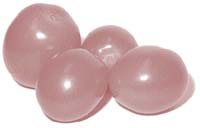Grape Tomatoes: Giving the Cherries a Run for Their Money
It's been nearly three years since I bought my first dry pint of grape tomatoes—and got hooked. At the time, these tasty treats were only available at trendy food stores like Fairway on Manhattan's Upper West Side. Nowadays, they are a supermarket sensation, flying off produce-department shelves all around the country.
So what's all the fuss about? At first glance, grape tomatoes don't look that different from red cherry tomatoes, which have been around for eons. (Prior to cultivation, the first tomato plants grew wild in Peru and Northern Chile, bearing pea- to cherry-sized fruits.) On closer inspection, however, you see that they are more elongated than cherries, shaped instead like olives or—yes, I have a genius for simile—like grapes.

Grape tomatoes combine a number of desirable tomato qualities, including very sweet flavor, firm texture, and at least the semblance of having been ripened on the vine. They don't have an inordinate amount of juice in them, so squirting accidents are minimized. Indeed, since these tomatoes average only about 1/2 to 3/4 inches in length, they pop right into your mouth, eliminating the squirt factor altogether.
Grape tomatoes also eliminate the "yuck" factor—kids love 'em! They gobble them up like candy. And they do it before, during, and after meals.
The grape tomato seems almost too good to be true—which is why I started to get suspicious. How come it appeared so suddenly? Where did it come from? Is it the product of old-fashioned breeding or the fruit of some weird laboratory experiment involving DNA splices from a microbe and a French Merlot? I decided to turn to some experts for help.
"The grape tomato that you see in most stores is the hybrid 'Santa F1' variety," explains Linda Sapp, horticulturist at the Tomato Growers Supply Company, in Fort Myers, Florida. "It was bred, I believe, using traditional techniques, by the Known-You Seed Company in Taiwan. Several years ago, Andrew Chu, a farmer from Manatee County, Florida, imported seed to this country. To my knowledge, he was the first to grow and market the 'Santa F1' as the 'grape tomato.'"
"Initially, it was a flop!" says Sapp. "Mr. Chu wasn't able to get anyone to buy his grape tomatoes. Today, of course, that's all changed. Grape tomatoes are everywhere and are giving the cherries a run for their money. But that doesn't mean it's easy to get hold of the 'Santa F1' seed."
The rise of the 'Santa F1' has created enormous competition among produce brokers and growers. In attempts to corner the grape tomato market, companies like the Procacci Brothers Sales Corporation of Philadelphia, Pennsylvania, have bought up as much of the 'Santa F1' seed as they possibly can.
"It's like with any successful start-up product," says Gary Ibsen, author of The Great Tomato Book and organizer of TomatoFest®, a charity event held annually in Carmel, California. "There's lots of incentive for a company with capital to want to pick it up and control its distribution and price."
Although Ibsen is not a big fan of hybrid tomatoes (selling only organic heirloom varieties on his web site), he has a professional, if somewhat guarded, admiration for the 'Santa F1'. "The tougher skin makes this variety a perfect candidate for modern mechanized mass production. Moreover, it packages well and ships beautifully."
Ibsen and other tomato gurus I consulted all say that 'Santa F1' was not the first grape-shaped tomato ever developed (only the most successful). And it's clear now that it won't be the last, either. With all the seed monopolizing that's going on, new grape tomato varieties are arriving on the market to fill the demand. The Tomato Growers Supply Company (phone: 888-478-7333), for example, has a new product called, simply, 'Grape Tomato', which it says is every bit as good as the 'Santa F1'.
However, for gardeners interested in recreating that unique, first-time, supermarket-fresh grape-tomato experience at home, I found a retail seed source for the 'Santa F1' hybrid: Thompson & Morgan Ltd. (phone: 800-274-7333). Better hurry though. I heard it on the grapevine that they're selling fast.


